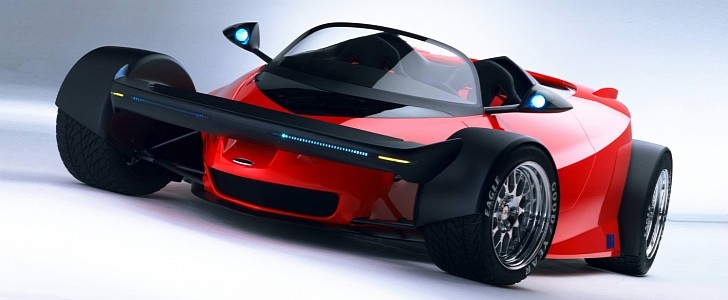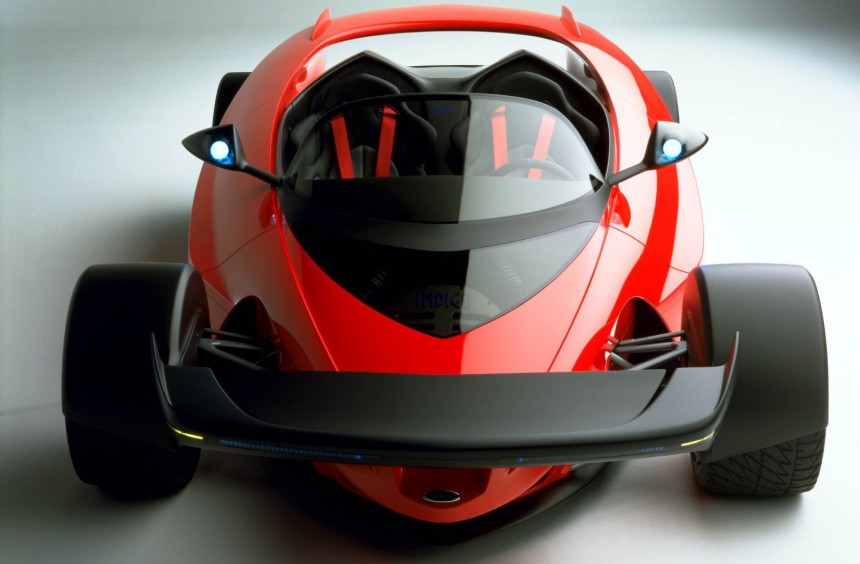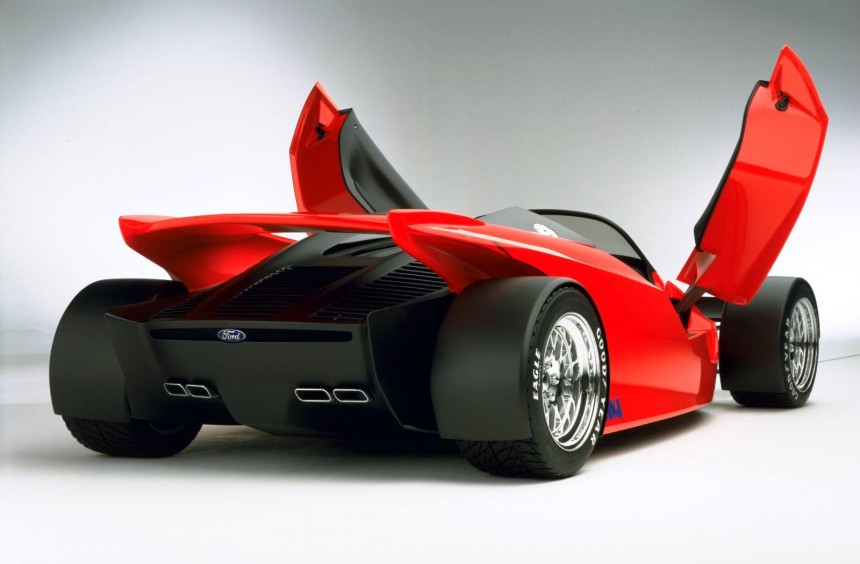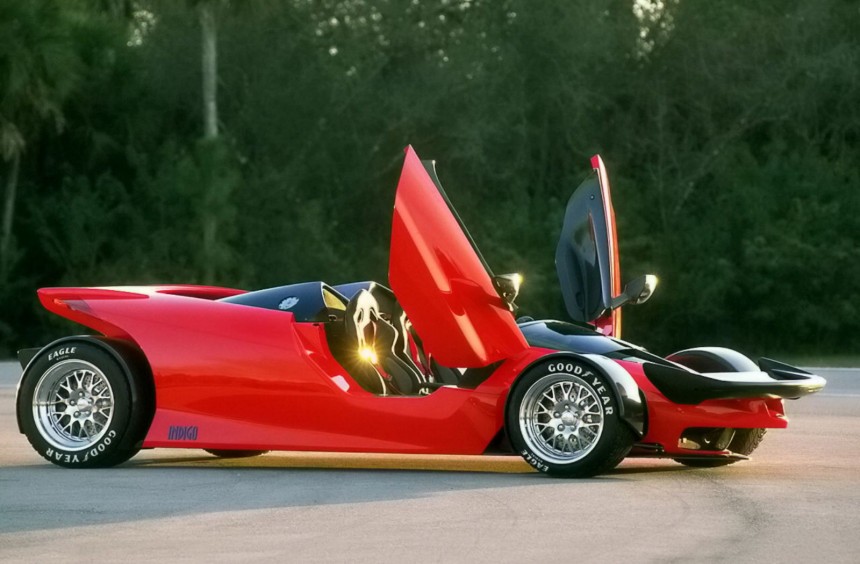If you grew up in the 1990s, you might remember the Indigo from the Need for Speed II videogame. However, this wasn’t just a virtual racer but a fully functioning concept that was conceived as an Indy car for the streets.
For the world’s top carmakers, especially those based in the U.S., the Detroit Auto Show is the most important event of the year. In the first half of the 1990s, Ford seemed to be eclipsed by its rivals every year, so for 1996, management decided to pull out all the stops and reveal one of the most outrageous concept cars to ever don the blue oval badge.
Jac Nasser, the company's vice president of product development at the time, instructed Claude Lobo, the director of the Advanced Design Studio in Dearborn, Michigan, to create it. The latter assembled a small team of talented designers, and, along with a group of engineers from the Advanced Vehicle Technology department, they immediately got to work.
Legend has it that at first, the designers drew up several sketches inspired by the supercars of the era, but the results were far from being mind-blowing. The idea of designing a road-legal open-wheeler came about when the team watched an IndyCar race that was won by 1995 champion Jacques Villeneuve while driving a Reynard-Ford.
Once everyone agreed on a final design, it only took about 6 months to complete two versions of the concept, which was now called Indigo. One was a static prototype with no engine that would tour the world's most important auto shows, while the other, nicknamed Go, was fully functional.
The carbon fiber body finished in bright red paint was nearly identical on both versions. It came with scissor-style doors, xenon headlamps incorporated into the side mirrors, and a high-mounted front wing that some say looked like an awful mustache while others call it the defining feature of the concept. Unlike the functional Go, the static show car was equipped with a small windshield, which is the only noticeable difference between the two cars.
The Indigo boasted numerous features and technologies inspired by open-wheel race cars, like the single-piece carbon fiber monocoque developed alongside Reynard Motorsport, the company responsible for Jacques Villeneuve’s title-winning chassis.
Next up is the suspension, which utilized an Indy car-derived double wishbone system with pushrods and inboard coil-over shock absorbers. Moving on to the braking system, the massive cross-drilled Brembo rotors were comparable to those found on Formula 1 cars.
The fully functional Go was powered by a 6.0-liter V12 that could spit out 435 hp (324 kW) at 6,100 rpm and 405 lb-ft (549 Nm) of torque at 5,250 rpm.
No, this was not an Indy or Formula 1 unit, but it was designed in collaboration with Cosworth, one of the leading manufacturers of racing engines. It had a new aluminum block and cylinder heads, but the basic architecture, as well as many internals like the pistons, rings, conrods, and the valve train, were taken from Ford's plebian Duratec V6 engine found in the Taurus and Mercury Sable. Despite this, it produced the goosebump-inducing sound you’d expect from a V12, and you can hear it for yourself in the video below posted on YouTube by ROUSHperformance.
The powerplant was bolted directly to the chassis, acting as a stressed member for several suspension components, a layout also utilized by open-wheel racers. It was linked to a Reynard 6-speed electro-hydraulic sequential, a slightly modified version of the gearbox used in the Indy cars. It could be operated via steering wheel-mounted push buttons, the precursors of today’s paddle shifters, yet another feature derived from motorsport.
According to Ford’s estimates, the Indigo could accelerate from 0 to 60 mph (97 kph) in under 4 seconds, run the quarter-mile (402 m) in 11.9 seconds, and reach a theoretical top speed of 180 mph (290 kph). However, these figures were never independently put to the test.
The concept car eventually managed to make a splash at the 1996 Detroit Auto Show, but the star attraction became the Mercedes-Benz AAVision concept.
Although we wish they did, Blue Oval management never considered a limited production run of the Indigo. However, its capable V12 went on to power various Aston Martin models since Ford owned the British brand until 2007.
Today, 25 years after its unveiling, this awesome take on a road-legal open-wheeler remains one of the coolest concept cars of the 1990s and one of Ford’s most daring projects.
Jac Nasser, the company's vice president of product development at the time, instructed Claude Lobo, the director of the Advanced Design Studio in Dearborn, Michigan, to create it. The latter assembled a small team of talented designers, and, along with a group of engineers from the Advanced Vehicle Technology department, they immediately got to work.
Legend has it that at first, the designers drew up several sketches inspired by the supercars of the era, but the results were far from being mind-blowing. The idea of designing a road-legal open-wheeler came about when the team watched an IndyCar race that was won by 1995 champion Jacques Villeneuve while driving a Reynard-Ford.
The carbon fiber body finished in bright red paint was nearly identical on both versions. It came with scissor-style doors, xenon headlamps incorporated into the side mirrors, and a high-mounted front wing that some say looked like an awful mustache while others call it the defining feature of the concept. Unlike the functional Go, the static show car was equipped with a small windshield, which is the only noticeable difference between the two cars.
The Indigo boasted numerous features and technologies inspired by open-wheel race cars, like the single-piece carbon fiber monocoque developed alongside Reynard Motorsport, the company responsible for Jacques Villeneuve’s title-winning chassis.
The fully functional Go was powered by a 6.0-liter V12 that could spit out 435 hp (324 kW) at 6,100 rpm and 405 lb-ft (549 Nm) of torque at 5,250 rpm.
No, this was not an Indy or Formula 1 unit, but it was designed in collaboration with Cosworth, one of the leading manufacturers of racing engines. It had a new aluminum block and cylinder heads, but the basic architecture, as well as many internals like the pistons, rings, conrods, and the valve train, were taken from Ford's plebian Duratec V6 engine found in the Taurus and Mercury Sable. Despite this, it produced the goosebump-inducing sound you’d expect from a V12, and you can hear it for yourself in the video below posted on YouTube by ROUSHperformance.
According to Ford’s estimates, the Indigo could accelerate from 0 to 60 mph (97 kph) in under 4 seconds, run the quarter-mile (402 m) in 11.9 seconds, and reach a theoretical top speed of 180 mph (290 kph). However, these figures were never independently put to the test.
The concept car eventually managed to make a splash at the 1996 Detroit Auto Show, but the star attraction became the Mercedes-Benz AAVision concept.
Although we wish they did, Blue Oval management never considered a limited production run of the Indigo. However, its capable V12 went on to power various Aston Martin models since Ford owned the British brand until 2007.
Today, 25 years after its unveiling, this awesome take on a road-legal open-wheeler remains one of the coolest concept cars of the 1990s and one of Ford’s most daring projects.










